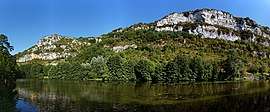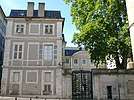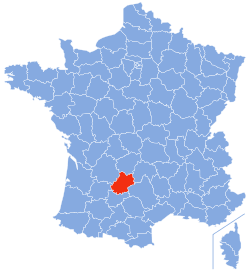Lot (department)
Lot (French pronunciation: [lɔt];[1] Occitan: Òlt [ɔl]) is a department in the Occitanie region of France. Named after the Lot River, it lies in the southwestern part of the country and had a population of 173,758 in 2013. Its prefecture is Cahors; its subprefectures are Figeac and Gourdon.
Lot | |
|---|---|
     From top down, left to right: Figeac, Rocamadour, Faycelles, Lot River, prefecture building in Cahors and Luzech | |
 Flag  Coat of arms | |
 Location of Lot in France | |
| Coordinates: 44°35′N 01°35′E | |
| Country | France |
| Region | Occitanie |
| Prefecture | Cahors |
| Subprefectures | Figeac Gourdon |
| Government | |
| • President of the Departmental Council | Serge Rigal (REM) |
| Area | |
| • Total | 5,217 km2 (2,014 sq mi) |
| Population (2016) | |
| • Total | 173,347 |
| • Rank | 92nd |
| • Density | 33/km2 (86/sq mi) |
| Time zone | UTC+1 (CET) |
| • Summer (DST) | UTC+2 (CEST) |
| Department number | 46 |
| Arrondissements | 3 |
| Cantons | 17 |
| Communes | 313 |
| ^1 French Land Register data, which exclude estuaries, and lakes, ponds, and glaciers larger than 1 km2 | |
History
Lot is one of the original 83 departments created during the French Revolution on 4 March 1790. It was created from part of the province of Quercy. In 1808 some of the original southeastern cantons were separated from it to form the department of Tarn-et-Garonne. It originally extended much farther to the south and included the city of Montauban.
Geography

Lot is part of the region of Occitanie and is surrounded by the departments of Corrèze, Cantal, Aveyron, Tarn-et-Garonne, Lot-et-Garonne and Dordogne.
Cahors is the prefecture of the department, lying in its southwestern part: a medieval cathedral town known internationally for its production of Cahors wine, it lies in a wide loop of the Lot River and is famous for its 14th-century bridge, the Pont Valentré. Figeac is a medieval town where Jean-François Champollion, the first translator of Egyptian hieroglyphics, was born, situated in the eastern part of Lot. Gourdon, a medieval hilltop town located in Lot's northwestern part, with a well preserved centre, comprises many prehistoric painted caves nearby, notably the Grottes de Cougnac.
Demographics
The inhabitants of Lot are called Lotois and Lotoises is French. Population development since 1801:
| Historical population | ||
|---|---|---|
| Year | Pop. | ±% p.a. |
| 1801 | 261,207 | — |
| 1806 | 268,149 | +0.53% |
| 1821 | 275,296 | +0.18% |
| 1831 | 284,505 | +0.33% |
| 1841 | 287,739 | +0.11% |
| 1851 | 296,224 | +0.29% |
| 1861 | 295,542 | −0.02% |
| 1872 | 281,404 | −0.44% |
| 1881 | 280,269 | −0.04% |
| 1891 | 253,939 | −0.98% |
| 1901 | 226,720 | −1.13% |
| 1911 | 205,769 | −0.96% |
| 1921 | 176,889 | −1.50% |
| 1931 | 166,637 | −0.60% |
| 1936 | 162,572 | −0.49% |
| 1946 | 154,897 | −0.48% |
| 1954 | 147,754 | −0.59% |
| 1962 | 149,929 | +0.18% |
| 1968 | 151,198 | +0.14% |
| 1975 | 150,778 | −0.04% |
| 1982 | 154,533 | +0.35% |
| 1990 | 155,816 | +0.10% |
| 1999 | 160,197 | +0.31% |
| 2006 | 169,533 | +0.81% |
| 2016 | 173,347 | +0.22% |
| source:[2] | ||
Politics
Departmental Council of Lot
The Departmental Council of Lot has 34 seats. Since the 2015 departmental elections, 30 are controlled by the Socialist Party (PS) and its allies; 4 are controlled by the miscellaneous right. Since 2014, the President of the Departmental Council has been Serge Rigal, currently a member of La République En Marche! (REM).
Members of the National Assembly
Lot elected the following members of the National Assembly during the 2017 legislative election:
| Constituency | Member[3] | Party | |
|---|---|---|---|
| Lot's 1st constituency | Aurélien Pradié | The Republicans | |
| Lot's 2nd constituency | Huguette Tiegna | La République En Marche! | |
Senators
Lot is represented in the Senate by Angèle Préville (since 2017) and Jean-Claude Requier (since 2011).
Popular culture
Lot is mentioned in popular culture:
- French singer-songwriter Léo Ferré lived in the Lot for a while.
- At Home in France, by Ann Barry; a humorous account of owning a vacation cottage in Lot
References
- "lot - Deutsch-Übersetzung - Langenscheidt Französisch-Deutsch Wörterbuch" (in German and French). Langenscheidt. Retrieved 22 October 2018.
- Site sur la Population et les Limites Administratives de la France
- http://www.assemblee-nationale.fr/
External links
| Wikimedia Commons has media related to Lot (département). |
- (in French) Prefecture website
- (in French) General council website
- (in English) hiking the Tour du Lot
- (in French) CazalRando groupe de randonnée pédestre website



